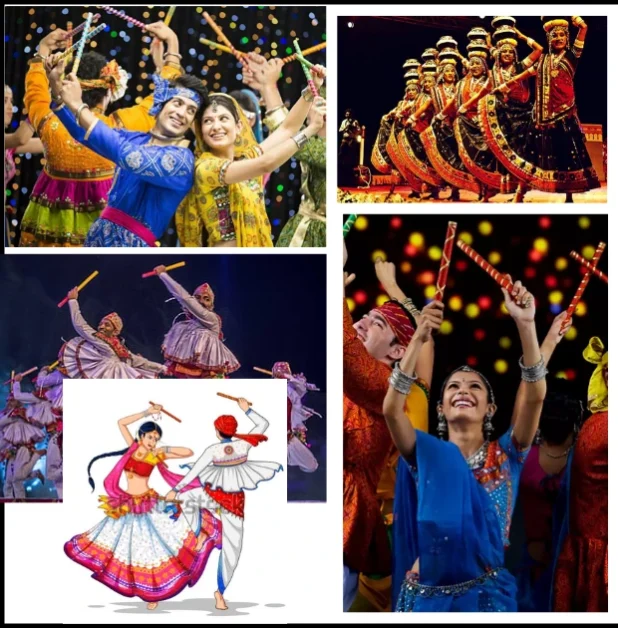Gujarat, a land brimming with cultural diversity and rich traditions, boasts an exquisite tapestry of folk dances that reflect the state’s essence and vibrancy. These dances are not just a source of entertainment but also a window into Gujarat’s historical, social, and religious facets.
In this article, you will get to know about the folk dances of Gujarat, exploring their origins, significance, and the colorful stories they tell.
Introduction to Folk Dances of Gujarat
The Folk Dances of Gujarat are a window into the past, a legacy that has been lovingly handed down from one generation to the next. These dances, deeply influenced by the region’s diverse topography, religious beliefs, and customs, showcase a remarkable blend of artistry and cultural heritage. Both men and women participate in these performances, each dance style carrying its distinctive flair and rhythm.
Further, Gujarat’s folk dances offer a world of exuberance and togetherness. These dances are a lively tribute to life itself, echoing the happiness that defines the people of the state. With boundless enthusiasm, performers breathe life into these dances, captivating spectators with their mesmerizing displays.
Famous Folk Dance of Gujarat
Here’s a list of some famous folk dances of Gujarat:
- Garba
- Dandiya
- Bhavai
- Timpani
- Padhar
- Sidi Goma Dance
- Hudo

1. Garba
- Circular movements symbolize the cycle of life and unity, performed during Navratri to honor Goddess Amba or Durga.
- Vibrant Chaniya Cholis and Kediyus worn by dancers add cultural richness to the performance.
- Syncopated beats of Dhol and melodious Garba songs create an entrancing rhythm.
- Popular worldwide, Garba transcends borders and cultures, captivating enthusiasts globally.
- Traditional dance steps are passed down through generations, preserving the dance’s authenticity.
2. Dandiya
- Dynamic dance involves twirling sticks, representing Lord Krishna’s playful interaction with the Gopis.
- Men and women pair up, showcasing unity, coordination, and camaraderie.
- Lively beats and swift footwork radiate enthusiasm, turning gatherings into celebrations.
- Colorful costumes and vibrant accessories reflect the festive spirit of the dance.
- Dandiya originated as a form of worship to Goddess Amba and later evolved into a communal celebration.
3. Bhavai
- Performers balance pots on their heads while narrating stories, showcasing skill, and grace.
- Dance form depicts tales from mythology, folklore, and social issues.
- Inclusive participation includes both men and women, uniting genders in artistic portrayal.
- Performers’ ability to maintain balance while dancing reflects their exceptional physical control.
- Music and dance coalesce to create a captivating theatrical experience, evoking emotions.
4. Timpani
- Rhythmic footwork on a suspended plank showcases rhythmic precision.
- The creative incorporation of foot sounds enhances the auditory experience.
- Wooden plank challenge elevates the choreography’s complexity, requiring technical mastery.
- The dance form represents Gujarat’s commitment to preserving its unique cultural heritage.
- Footwork patterns are passed down through generations, ensuring the continuity of the art form.
5. Padhar
- Celebrates the agricultural abundance of the harvest season.
- Rhythmic footwork syncs with clapping, creating a harmonious symphony.
- Traditional attire mirrors the festive nature of the dance.
- Dance captures the communal spirit and unity of rural communities.
- Padhar’s continued practice reinforces Gujarat’s connection to its agrarian roots.
6. Sidi Goma Dance
- Reflects the cultural fusion between Gujarat and the African roots of the Sidi community.
- Vibrant attire reflects African heritage and Gujarat’s diversity.
- Accompanied by rhythmic drumming, creating a pulsating beat.
- Dance serves as a bridge between cultures, promoting understanding and appreciation.
- Expresses the shared history and acceptance of different traditions.
7. Hudo
- Portrays the daily life and struggles of the Maldhari community.
- Captures herding essence through rhythmic movements.
- Preserve the cultural heritage and showcase a unique way of life.
- Traditional costumes reflect the Maldhari lifestyle and connection with nature.
- Dance embodies the spirit of the Maldharis and their harmonious relationship with animals.
Importance of Folk Dance in Gujarat

Folk dances in Gujarat are more than movements; they embody the state’s culture and spirit. They bridge generations, preserve history, and transmit values. Through dances like Garba and Bhavai, traditions remain alive, fostering unity and identity.
These dances are a canvas of artistic expression, attracting tourists and preserving customs. By teaching history, celebrating diversity, and binding communities, folk dances safeguard Gujarat’s heritage, ensuring its endurance and enrichment.
Also Read: Folk Dances of Madhya Pradesh
Conclusion
The folk dances of Gujarat are more than rhythmic movements; they’re threads binding the state’s vibrant heritage. From the dynamic Garba to the spirited Dandiya Raas, each dance narrates stories of celebration and unity. Bhavai’s balance, Tippani’s rhythms, and Padhar’s harvest revelry showcase the state’s diversity.
These dances are living treasures, passed down to preserve Gujarat’s rich culture. They remind us that traditions thrive when woven into movement. Gujarat’s folk dances embody its past, present, and future, ensuring a legacy that endures.
Thank You!





